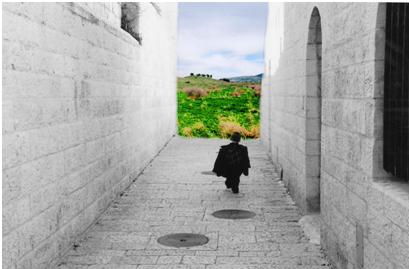I'm told that Shavuot is not a widely-celebrated holiday outside of Jerusalem. Last time I was in Israel, I was in a small town called Ben-Ayish, where Shavuot as known as a day off from school during which kids squirted water guns and threw water balloons. I did see one water gun fight in Gan Sacher over the two-day Shavuot break, but this seemed a pretty marginal aspect of the holiday in Jerusalem.
Shavuot is characterized by a number of pieces that are kind of hard to put together into one big picture.
1) The agricultural aspect: In Israel, the harvest began with barley in Passover and ended with wheat, on Shavuot- thus Shavuot celebrates the wheat harvest. In the days of the Temple, people would bring loaves of bread to be sacrificed in celebration of the harvest. The agricultural aspect seems to get much more emphasis here than in the US - I saw at least three preschool presentations about grinding wheat into flour and baking bread, and all the signs for Shavuot sales at the clothing stores have pictures of wheat stalks on them.
2) the food aspect: It is traditional to eat dairy on Shavuot. The explanation I've heard for this is that because Shavuot commemorates the giving of the Torah, it was the first time that the Israelites had heard the laws of kashrut and they did not yet have the proper equiptment and knowledge to slaughter meat properly, so they ate milk. Whatever the reason, it's a great holiday to be a vegetarian, but a lousy one for vegans. Traditional foods include cheesecake, blintzes, etc. Cheese itself is less popular. According to the Shavuot Nextbook podcast I listened to, Jews weren't big cheese consumers because most cheeses are made with rennet, an enzyme found in calves' stomachs. There are kosher cheeses, and I'm sure some people do eat cheese on Shavuot, but some of these softer cheese/milk products are more popular.
3) the giving of the Torah: As with many Jewish holidays, the agricultural and theological/historical/Biblical understandings are paired. Therefore, not only does the counting of the omer represent anticipating the wheat harvest, but it also anticipates the giving/receiving of the Torah on Mount Sinai.
4) reading the book of Ruth: It is traditional to read the Book of Ruth on the morning of Shavuot, as it takes place during the barley and wheat harvests and tells of a woman who, like the people of Israel on Mt. Sinai, accepts the Jewish tradition. The book of Ruth is the paradigm for conversion into Judaism, and as David was Ruth's descendant and the Messiah will be David's son, we can see how fully integrated Ruth was the Jewish tradition, despite having been born as a Moabite. The book of Ruth is also a favorite among feminists, as it portrays strong and revered women who have agency over their own lives.
5) all night Torah study: It is traditional among Askenazi communities to study Torah all night on Shavuot - the study can be of any holy book. In Jerusalem, it is traditional to finish the studying by walking to the Western Wall to perform the morning service there.
6) greenery - It is traditional to decorate homes and synagogues with greenery on Shavuot, because Mt. Sinai is said to have blossomed when G-d gave the Torah to the Israelites.
6) confirmation - in the US, progressive synagogues often hold their confirmation ceremonies on Shavuot, a ceremony to acknowledge the completion of post-Bar/Bat Mitzvah studying. As it falls at the end of the school year and is connected to a theme of receiving and accepting the Jewish tradition, confirmation fits nicely into the holiday.
My Shavuot experience began with services at Har El, which was actually quite crowded (I was surprised!) with an upbeat crowd. The cantor donned his special tall high-Reform black hat and performed a combinatin of traditional tunes and contemporary compositions. We read the first chapter of the book of Ruth, the rest was to be read at morning services. After the service, I went to the potluck at Har El, which was filled with fruit salads, egg and cheese dishes, and breads. My friends Rebecca and Aya joined me at the potluck and we chatted with congregants a bit before heading in to the lecture given by Rabbi Ada.
Rabbi Ada's lecture was about the coming of the Messiah. She explained what some Rabbinic sources have to say about questions of when and how the Messiah will come, what the Messiah will look like and do, what the world will be in the Messianic era. All of this was done with a sense of humor but also with a sense of hopefulness and faith, a balance between a liberal and modern perspective and a respect for and sharing in the hope of a perfect world to come. Rabbi Ada is terrific and I was proud that I understood almost all that she said.
Afterwards, Rebecca, Aya, and I went to HUC to do some more studying. HUC was all lit up, the fountain was running, and many classes were set up around the courtyard, in Hebrew, and one in English. We, along with several HUC students, attended a talk about the idea of chosen-ness and uniqueness in Judaism, followed by a presentation by Rabbi/Prof Michael Marmur in which we examined one verse and used it as a way to understand what it means to be a stranger or an outsider, and the value and difficulty this perspective presents.
We ended at about 3:00 in the morning, and while I could have waited and walked to the Western Wall at 4:00, I was too tired by that time and I went home to bed.
Saturday, May 30, 2009
Subscribe to:
Post Comments (Atom)

No comments:
Post a Comment